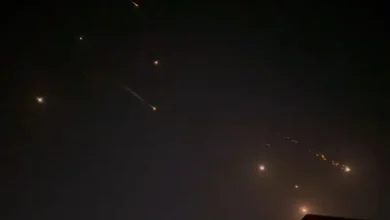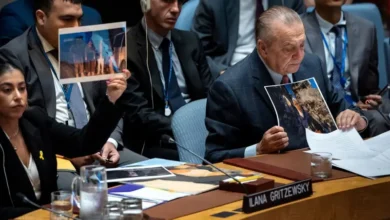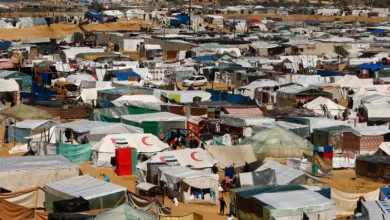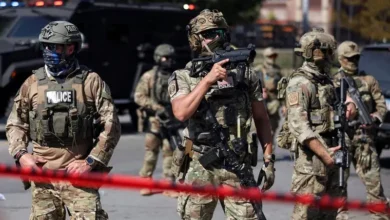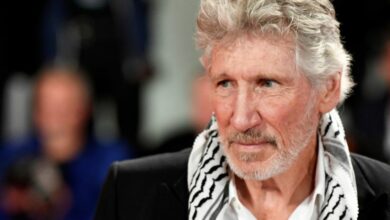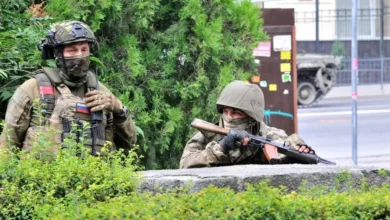Ukraine hits third bridge in Russia’s Kursk, says buffer zone is final goal

Moscow says Ukraine has struck and damaged a third bridge in the Kursk region as Kyiv forces attempt to expand its incursion within Russian territory.
Russia’s Investigative Committee on Monday confirmed the attack on the bridge located along the River Seym, which winds through Kursk.
Ukrainian authorities have yet to comment on the Russian claim.
In another sign of escalation on Monday, Russia said its marines captured a group of 19 Ukrainian soldiers in the region, the state RIA Novosti news agency reported. The outlet described the Ukrainians as “saboteurs”.
RIA posted what it said was a video of the captured troops. The video could not be confirmed independently.
Despite gains in Russia’s Kursk region, Ukrainian forces were on the defensive near the strategic eastern city of Pokrovsk, where Russia has steadily advanced in recent weeks.
The city, which had a pre-war population of around 60,000, is an important transport hub for Ukrainian supply lines in much of the eastern Donbas region.
Russian troops are now around 10km (6 miles) from the outskirts of the city, according to Serhiy Dobriak, head of the local military administration.
In comments to Ukrainian media on Monday, he said up to 600 people were leaving on a daily basis, and that municipal services could be cut off within a week as Russian forces close in.
‘Our primary task’
On Sunday, Ukraine said it had destroyed a second bridge across River Seym.
The attacks on the region’s bridges in a matter of days come as Ukraine presses a cross-border offensive that began on August 6.
On Friday, it said it had struck a bridge in the Russian town of Glushkovo.
Ukrainian President Volodymyr Zelenskyy has praised the incursion and stated its aims for the first time.
“It is now our primary task in defensive operations overall: to destroy as much Russian war potential as possible and conduct maximum counteroffensive actions. This includes creating a buffer zone on the aggressor’s territory,” he said in his evening address on Sunday.
The remarks give an idea of the “strategic Ukrainian thinking behind the incursion”, said Al Jazeera’s defence editor Alex Gatopoulos, reporting from Kyiv.
“It means local tactical success by Ukrainian forces, but it also means long-range Ukrainian strikes behind Russian front lines – attacking railroads, ammunition dumps, airbases, trying to destroy the jets that attack them. So, basically a combination of local successes and deep strikes – essentially to defang Russia’s military in the [area] so they can’t be nearly as aggressive, nearly as dangerous.”
He added that the talk of a buffer zone is “key” to Ukraine’s long-term thinking.
Ukraine “can’t keep advancing” in Kursk, he said. “Sooner or later they will run dry.”
The buffer zone Ukrainian forces hope to create is “so Russia can’t approach the border too closely and use its artillery and air strikes on it”, he said.
On Monday, Zelenskyy claimed Ukraine was achieving its goals in its two-week-old incursion.
According to Russia’s Mash news site, the attacks left only one bridge in the area intact, potentially complicating Moscow’s attempts to replenish its forces and evacuate civilians.
The incursion began with tanks and other armoured vehicles, the largest attack on Russia since World War II.
Ukraine’s military chief, Oleksandr Syrskii, claimed last week that his forces had advanced across 1,000sq km (390sq miles) of Kursk, although it was not possible to independently verify the extent of its control.
Zelenskyy has urged Kyiv’s allies to lift the remaining restrictions on the use of Western weapons on targets deeper inside Russia, including in Kursk, saying his troops could deprive Moscow “of any ability to advance and cause destruction” if granted sufficient long-range capabilities.
Ukraine says bases inside Russia have been used to launch long-range attacks on Ukraine’s cities and energy infrastructure, causing significant damage and casualties.
On Sunday, Moscow targeted Kyiv with ballistic missiles for a third time this month, according to officials.
Zelenskyy said Russia had launched more than 40 missiles, 750 guided aerial bombs and 200 attack drones against Ukrainian villages and cities in the past week alone.
“We’re hearing there has been some damage [in the Kyiv region] mostly from falling projectiles as air defences have intercepted the incoming missiles and drones, but the damage is minimal,” said Al Jazeera’s Gatopoulos.
“This is an ongoing thing, they happen almost every day. However, if they did get through, there would be significant damage on the ground as well.”
